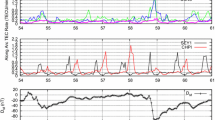Abstract
Indian regional navigation satellite system (IRNSS) or Navigation with Indian Constellation (NaVIC) is the satellite-based navigation system, established and controlled by the Indian Space Research Organization. It provides services of positioning, velocity, and timing for civilian and military applications. Ionospheric irregularities cause the fluctuations in the amplitude and phase of the received navigation signals; this phenomenon is known as scintillation. Scintillation can create the error in precise positioning and degrades the position accuracy of the navigation system. It varies with solar activity, geographical location, seasonal variation, day–night time, and elevation angle of satellites. The S4 index is one of the key parameters to estimate the amplitude scintillation to recognize the quality of the navigation signal. In this paper, amplitude scintillation characteristics are studied with IRNSS/GPS/SBAS in the Ahmedabad region which is at the average altitude of 53 m. S4 index is calculated and analyzed using the real-time navigation data of one week. Here, IRNSS/GPS/SBAS receiver with L1, L5, and S-band, is used to collect the data at low altitude station (IITRAM, Ahmedabad). The position error of normal sunny days is calculated using IRNSS/GPS/SBAS receiver. The probability of position error is also derived and found that it follows the gamma distribution function and validate it statistically using a chi-square test. This study also focuses on the effect of elevation of the satellite on the value of carrier to noise ratio at the location of IITRAM.









Similar content being viewed by others
References
Acharya R, Majumdar S (2019) Statistical relation of scintillation index \(S\)4 with ionospheric irregularity index ROTI over Indian equatorial region. Adv Space Res 64(5):1019–1033
Acharya R, Nagori N, Jain N, Sunda S, Regar S, Sivaraman M, Bandopadhyay K (2007) Ionospheric studies for the implementation of GAGAN. Indian J Radio Space Phys 36:394–404
Brahmanandam PS, Uma G, Liu JY, Chu YH, Latha Devi NSMP, Kakinami Y (2012) Global S4 index variations observed using FORMOSAT‐3/COSMIC GPS RO technique during a solar minimum year. J Geophys Res 117:1–31. https://doi.org/10.1029/2012JA017966
Carrano CS, Groves KM, Rino CL (2019) On the relationship between the rate of change of total electron content index (ROTI), irregularity strength (C k L ), and the scintillation index (\(S\)4). J Geophys Res Space Phys 124:2099–2112. https://doi.org/10.1029/2018JA026353
Chakraborty S, Chatterjee S, Jana D (2017) A study on multifrequency scintillations near the EIA crest of the Indian zone. Adv Space Res 60(8):1670–1687
Chen S, Bilitza D, Liu J, Caton R, Chang L, Yeh W (2017) An empirical model of \(L\)-band scintillation \(S\)4 index constructed by using FORMOSAT-3/COSMIC data. Adv Space Res 60(5):1015–1028
de Oliveira Nascimento Brassarote G, de Souza E, Monico J (2017) \(S\) 4 index: does it only measure ionospheric scintillation? GPS Solut. https://doi.org/10.1007/s10291-017-0666-x
Desai M, Shah S (2018) The GIVE ionospheric delay correction approach to improve positional accuracy of Navic/IRNSS single-frequency receiver. Current Sci 114(08):1665
Guo K, Aquino M, Veettil SV (2019) Ionospheric scintillation intensity fading characteristics and GPS receiver tracking performance at low latitudes. GPS Solutions 23(2)
He Z, Zhao H, Feng W (2016) The ionospheric scintillation effects on the beidou signal receiver. Sensors 16 (11):1883
Indian Regional Navigation Satellite System (2017) Signal in space ICD for standard positioning service, version-1.1, ISRO-IRNSS-ICD-SPS-1.1
Jacobsen K, Dhnn M (2014) Statistics of ionospheric disturbances and their correlation with GNSS positioning errors at high latitudes. J Space Weather Space Clim 4:A27
Jianjun H, Cheng C, Li H, Qiusheng H (2006) Effect of ionosphere refraction on satellite navigation precision. In: 2006 7th international symposium on antennas, propagation and EM theory
Jiao Y, Morton Y (2015) Comparison of the effect of high latitude and equatorial ionospheric scintillation on GPS signals during the maximum of solar cycle 24. Radio Sci 50(9):886–903
Parmar S et al (2017) A comparative analysis of ionospheric effects on Indian Regional Navigation Satellite System (IRNSS) signals at low latitude region, Surat, India using GDF and Nakagami-m Distribution. In: International conference on future internet technologies and trends ICFITT 2017: future internet technologies and trends, pp 126–136. https://doi.org/10.1007/978-3-319-73712-6_13
Rawat A, Savaliya J, Chhabhaya D (2019) Field trial of IRNSS receiver. Microw Opt Technol Lett 61(5):1149–1153
Rino C, Morton Y, Breitsch B, Carrano C (2019) Stochastic TEC structure characterization. J Geophys Res Space Phys 124:10571–10579. https://doi.org/10.1029/2019JA026958
Romero R, Dovis F (2013) Effect of interference in the calculation of the amplitude scintillation index \(S\)4. In: 2013 international conference on localization and GNSS (ICL-GNSS)
Shahana K (2017) Ionospheric scintillation characteristics in IRNSS L5 and S-band signals. Indian J Radio Space Phys. https://www.researchgate.net/publication/324006991_Ionospheric_scintillation_characteristics_in_IRNSS_L5_and_S-band_signals
Sharma A, Gurav O, Bose A, Gaikwad H, Chavan G, Santra A, Kamble S, Vhatkar R (2019) Potential Of IRNSS/Navic \(L\)5 signals for ionospheric studies. Adv Space Res 63(10):3131–3138
Steenburgh RA, Smithtro CG, Groves KM (2008) Ionospheric scintillation effects on single frequency GPS. Space Weather 6:1–12. https://doi.org/10.1029/2007SW000340
Ya’acob N, Abdullah M, Ismail M (2010) GPS total electron content (TEC) prediction at ionosphere layer over the equatorial region. Trends Telecommun Technol. https://doi.org/10.5772/8474. https://www.intechopen.com/books/trends-in-telecommunications-technologies/gps-total-electron-content-tec-prediction-at-ionosphere-layer-over-the-equatorial-region
Acknowledgments
We would like to express thanks to SAC ISRO (Indian Space Research Organization), Ahmedabad to provide IRNSS/GPS/SBAS receiver for the field trails. We are also thankful to the team of Accord Systems, Bengaluru for providing technical support.
Author information
Authors and Affiliations
Corresponding author
Ethics declarations
Conflict of interest
The authors hereby confirm that there is no conflict of interest with respect to the current manuscript.
Rights and permissions
About this article
Cite this article
Prajapati, M., Rawat, A. & Sharma, S. Characterization of amplitude scintillation and distribution of positioning error for IRNSS/GPS/SBAS receiver. Acta Geophys. 69, 323–333 (2021). https://doi.org/10.1007/s11600-020-00507-z
Received:
Accepted:
Published:
Issue Date:
DOI: https://doi.org/10.1007/s11600-020-00507-z




